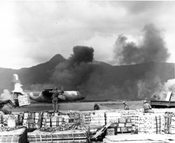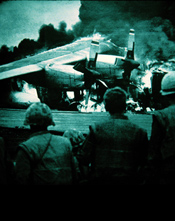- Exhibits
- Tet Offensive
- Khe Sanh
- Air Support
The Tet Offensive (Tết Mậu Thân)
- The Tet Offensive (Tết Mậu Thân)
- Hue: The Imperial City
- The Battle of Khe Sanh
- The Battle for Saigon
- Aftermath of the BattlesPolitical ConsequencesExhibit Credits
Air Support

"C-130 Landing at Khe Sanh Under Fire. Getting there was half the story."
(Peter Braestrup Collection [va035397])Gen William C. Westmoreland, commander of Military Assistance Command, Vietnam (MACV), ordered the United States Air Force to commence Operation NIAGARA to help the Marines withstand the NVA pressure on Khe Sanh. An average of 350 tactical fighter-bombers, 60 B-52 Stratofortresses, and 30 reconnaissance aircraft operated around the Khe Sanh area daily. By the end of the battle, fighter-bombers from the 7th Air Force alone flew 9,961 tactical sorties and dropped 14,223 tons of bombs in the area. The 1st Marine Air Wing deployed 7,078 sorties, dropping 17,015 tons of bombs. The Navy also redirected some of its aircraft missions from Operation ROLLING THUNDER to the Khe Sanh area, resulting in 5,337 sorties with a total of 7,941 tons of bombs dropped.
In addition to tactical fighter-bombing in the Khe Sanh area, B-52s from Operation ARC LIGHT were unleashed on the NVA. Operation ARC LIGHT was the name given to the deployment of B-52s stationed in Guam to support ground operations in Vietnam. ARC LIGHT’s number of sorties, 2,548, was relatively low compared to Operation NIAGARA, but the sheer amount of bombs the B-52s dropped consisted of an incredible 59,542 tons.
The Khe Sanh base was dependent on airpower not only for aerial protection; it was also dependent on it for supplies. The NVA had cut off Route 9, which was the main road to the base, leaving Khe Sanh completely dependent on receiving supplies through the air. There were multiple factors making it difficult to resupply Khe Sanh through the air, however. Not only did pilots have to contend with NVA artillery, they also had to deal with heavy fog and monsoons. As a result of these extreme conditions, an estimated 65% of the supplies delivered to the base were parachuted in by C-130s. The Air Force sent 14,356 tons of provisions to Khe Sanh while the 1st Marine Aircraft Wing was responsible for delivering 4,661 tons. Aside from the aerial supplies and fire support Khe Sanh received, the base also received troop reinforcements consisting of the 1st Battalion, 9th Marines, which arrived on 22 January, and the 37th ARVN Ranger Battalion, which arrived on 27 January.
Vietnam Center & Sam Johnson Vietnam Archive
-
Address
Texas Tech University, Box 41041, Lubbock, TX 79409 -
Phone
(806)742-9010 -
Email
vnca@ttu.edu


